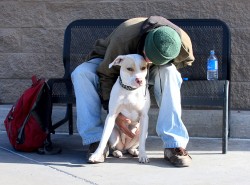News | January 27th, 2016

Recently during the debate over whether to bring refugees into America, many have wondered about the help available for our citizens who are hurting, in particular veterans. We sought to find out by asking Diana Hall, Supervisor of Homeless Programs at the Fargo VA, about what they do to help homeless veterans and learned that in the last 7 years, they’ve been able to drastically reduce the number of homeless veterans in the state by providing them with permanent shelter and help.
HPR: There has been some talk about how there’s no help out there for homeless veterans, can you talk a little bit about what help there is for homeless veterans and what you guys do to get the help to them?
Diana Hall: There’s actually a lot of help for homeless veterans nationally and locally. I think the big challenge is in extremely rural areas. You just can’t provide everything everywhere so veterans who become homeless in very rural areas that really have very limited options and have to come to more populated areas to access resources. But we have a fairly full continuum of care throughout the state. Our primary hub for providing services to homeless veterans, of course our home base is here in the Fargo-Moorhead area. But we also have VA workers and programs in Grand Forks, Bismarck, Minot, Dickinson and Williston so we kind of try to cover as much of the state as we can by dividing ourselves up through those metropolitan areas. What that continuum of care provides is we have street outreach where we look for and meet with veterans at community shelters, out in streets, in coffee shops in the community and try to get them in emergent shelter if they are actually homeless at that time.
HPR: What are the challenges with the people who don’t know the help is out there or maybe are in such a state they can’t get the help?
DH: I think we have two challenges in the state. The rurality of our state is very challenging and we do our best to overcome that. I think the other one is just getting the word out there. I think one of the things I most frequently hear from people is when I tell them about all of the opportunities for care that we provide for housing, for treatment and all kinds of things. People often say oh my gosh, I never knew the VA did such things. So I think despite our best efforts to really call attention to things that we are providing and that our community partners provide and work with us to provide, is really getting the word out there, that it’s available.
HPR: How best do you do that, get the word out?
DH: Well we have websites and a Facebook page and we do radio advertising for outreach events and a lot of our publicity is taken care of by the VA, there are folks who do that. It’s all over the internet I know that. It’s not difficult to find. But I think sometimes people don’t expect it to be there which is a challenge. In addition to homeless outreach, we actually have Veterans beds at almost every shelter in the state. We have a contract with Ruth Meiers in Bismarck, with all of the shelters in the Fargo Moorhead area and with the Grand Forks mission, we have Veterans specific beds at those places. While we don’t have a contract with them, we do work very closely with the Men’s Winter Refuge in Minot. There are no shelters in Williston and Dickinson unfortunately, it’s been very tough out there. And then in addition to that, we have permanent supportive housing, we have over 100 units for permanent supportive housing here in Fargo and Moorhead, we have over 25 in Grand Forks and then we also have those units in Dickinson, Williston, Bismarck and Minot. So we’re able to offer outreach to veterans on the street, provide transitional or temporary housing shelter and also provide permanent housing in each of those locations. And it’s really important to us to get that word out there as much as we can.
HPR: We’ve heard in the past about the challenges of the bureaucracy with this system, the delays and what it takes to get them the care. How do you deal with that once you get somebody in the system? How do get them the care quickly, efficiently and correctly?
DH: Well in the Fargo Moorhead VA Homeless Programs, we don’t require appointments. Access is always on demand and immediate. Anybody can come into the Fargo VA during our duty hours and access services for homeless veterans. After hours, if a veteran were homeless and presented to our department after hours, they have immediate access to emergency shelter. That’s available to them 24-7. We actually contract with the Gladys Ray Shelter to provide after hours triage so that any veteran who presents when the social workers arent’t there during the day can immediately be sheltered until we can get to them the next day.
HPR: The notion that some people are slipping through the cracks is it just that some people don’t know about it or just aren’t getting the help or is it just a little bit of a misnomer there?
DH: I know that we’ve got very few homeless veterans left in our state. We started out in 2008 with a census of about 800 on any given night and last year we could only find 40. So there’s been a substantial improvement. In fact, we’re just getting ready on Friday of this week is our annual point in time count and we will be working with state officials to see how many unsheltered veterans we can find in the state of North Dakota and also western Minnesota which the Fargo VA actually covers. It’s our hope to not find very many, we probably will still find some but it’s our hope that it will be very, very few. Certainly under 40 but we will see what happens after Friday’s point in time count. I think that sometimes have in their mind an image of decades of veterans who are homeless, on the streets, under bridges and that image is some firmly engraved in people’s mind, that the fact that over 800 veterans have been housed in North Dakota during our Ending Veterans Homeless Initiative, that I think people don’t realize that we’ve actually been able to do this work well.
HPR: If somebody knows a homeless veteran looking for help, what should they do?
DH: They should get that veteran down to the VA. Brin g them down we will take them any time they can come in, we want a warm handoff. We want them brought to us. We can provide shelter and access within three days to transitional housing and access in under 90 days to permanent housing. If there is a veteran who is homeless, we want them to come to us.
The Fargo VA is online at http://www.fargo.va.gov/ and their telephone number is 701-239-3700.
November 14th 2025
October 13th 2025
October 13th 2025
October 6th 2025
September 29th 2025

_(1)__293px-wide.jpg)